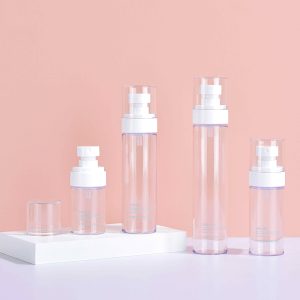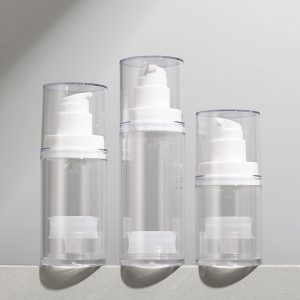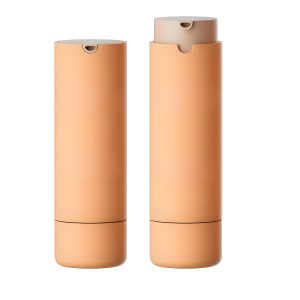에어리스 펌프 보틀은 리필이 가능한가요?
콘텐츠 메뉴
● The Airless Pump Bottle: A Sustainable Packaging Choice?
● The Rise of Airless Pump Bottles
● Benefits of Airless Pump Bottles
● Are Airless Pump Bottles Refillable?
● Moving Towards a Sustainable Future
● The Importance of Collaboration:
● The Future of Refillable Packaging
● Beyond Airless Pump Bottles:
● The Benefits of Refillable Packaging:
The Airless Pump Bottle: A Sustainable Packaging Choice?
Airless pump bottles have gained immense popularity in the beauty and personal care industry. Their unique design promises to protect delicate formulas from oxidation, contamination, and environmental factors, while offering a convenient and hygienic dispensing system. However, with growing concerns about sustainability and waste reduction, a crucial question arises: Are airless pump bottles refillable?
This article dives into the world of airless pump bottles, exploring their benefits, drawbacks, and the crucial question of refillability. We’ll examine the various options for refilling these containers, assess their feasibility and practicality, and discuss the implications for a more sustainable future in the beauty industry.

The Rise of Airless Pump Bottles
Airless pump bottles revolutionized the way we dispense and preserve delicate products. Their unique design, featuring a flexible inner chamber and a pump mechanism, ensures that only the required amount of product is dispensed, leaving the rest untouched by air. This minimizes contact with oxygen, preventing oxidation and preserving the product’s integrity and efficacy.
Benefits of Airless Pump Bottles
-
Preservation: The airless design effectively shields the product from oxidation, preserving its potency, color, and fragrance over time. This is particularly crucial for delicate formulas like serums, oils, and creams.
-
위생: Airless pumps eliminate the need for direct contact with the product, minimizing contamination from fingers or external sources. This feature makes them ideal for products intended for sensitive skin or those prone to bacterial growth.
-
편리한 디스펜싱: The pump mechanism delivers a precise and controlled dose, preventing wastage and ensuring consistent application.
-
Sleek Aesthetics: Airless pump bottles offer a modern and aesthetically pleasing presentation, enhancing the overall appeal of the product.
The Sustainability Dilemma
Despite their benefits, airless pump bottles are not without their challenges, particularly concerning sustainability. The majority of these bottles are made from plastic, raising concerns about environmental impact. While some are made from recyclable materials, the intricate design and the presence of multiple components can complicate the recycling process, often leading to them ending up in landfills.
Are Airless Pump Bottles Refillable?
The question of refillability is crucial to addressing the sustainability concerns surrounding airless pump bottles. The answer, unfortunately, is not straightforward.
The Challenges:
-
Design Complexity: The intricate design of airless pump bottles makes refilling a challenging task. The inner chamber is often difficult to access and the pump mechanism can be delicate, increasing the risk of damage or malfunction during the refilling process.
-
Material Compatibility: The materials used for the bottle and the pump need to be compatible with the refillable product. Some formulations might react negatively with certain plastics, leading to degradation or leakage.
-
Safety Concerns: If not done properly, refilling can compromise the hygiene and integrity of the product. Contamination can occur if the bottle is not cleaned thoroughly before refilling, or if the pump mechanism is not sanitized.
Refilling Options:
Despite these challenges, there are several ways to refill airless pump bottles, each with its own advantages and disadvantages:
-
DIY Refilling: This involves carefully removing the pump, cleaning the bottle thoroughly, and transferring the product from a separate container. While cost-effective, this method is not ideal for all bottle designs and requires careful handling to avoid damaging the pump or introducing contamination.
-
Refill Cartridges: Some brands offer refill cartridges designed specifically for their airless pump bottles. These cartridges are typically made from recyclable materials and provide a more convenient and hygienic refilling experience. However, the availability of these cartridges is limited, and they are often sold separately, adding to the overall cost.
-
Reusable Bottles: Some manufacturers offer reusable airless pump bottles that can be refilled with the same product or with other compatible formulations. These bottles are often made from durable materials like glass or stainless steel, promoting a more sustainable approach to packaging.
Moving Towards a Sustainable Future
While refilling airless pump bottles presents challenges, it’s a crucial step towards a more sustainable future in the beauty industry. By prioritizing refillable options, manufacturers can significantly reduce plastic waste and minimize their environmental footprint.
The Importance of Collaboration:
To make refillable airless pump bottles a reality, collaboration is essential.
-
Consumers: Consumers need to be informed about the refillable options available and be willing to embrace them. This requires clear communication from manufacturers and a shift in consumer behavior towards prioritizing sustainability.
-
Manufacturers: Manufacturers need to invest in designing and producing refillable airless pump bottles that are easy to refill and compatible with a wide range of products. They can also provide clear instructions and resources to guide consumers through the refilling process.
-
Regulatory Bodies: Regulations and standards need to be in place to ensure the safety and efficacy of refilled products. This includes guidelines for cleaning and refilling procedures, as well as the use of compatible materials.
The Future of Refillable Packaging
The future of refillable packaging is promising. Increasing consumer demand for sustainable alternatives is driving innovation in the packaging industry. Companies are investing in developing refillable systems that are convenient, safe, and environmentally friendly.
Beyond Airless Pump Bottles:
The concept of refillable packaging extends beyond airless pump bottles. Companies are exploring various options, such as:
-
Refillable Compacts: Refillable compacts for makeup products offer a convenient and sustainable solution for compact powders and foundations.
-
Reusable Cartridges: Reusable cartridges for products like shampoo, conditioner, and hand wash offer a more efficient and environmentally friendly way to dispense and refill these products.
-
Refill Stations: Refill stations are becoming increasingly popular, allowing consumers to refill their own containers with products like hand soap, laundry detergent, and cleaning solutions.
The Benefits of Refillable Packaging:
-
Reduced Waste: Refillable packaging significantly reduces plastic waste and contributes to a more circular economy.
-
Cost Savings: Refillable products can be more cost-effective in the long run, as consumers only need to purchase refills, saving on the cost of new packaging.
-
지속 가능성: Refillable packaging supports a more sustainable approach to product consumption, reducing environmental impact and promoting a circular economy.
Conclusion:
The question of whether airless pump bottles are refillable is complex and multifaceted. While the intricate design and the need for careful handling present challenges, there are viable options for refilling these containers.
By prioritizing refillable options and promoting collaboration between consumers, manufacturers, and regulatory bodies, we can collectively work towards a more sustainable future for the beauty industry. Embrace refillable packaging and join the movement towards a cleaner and greener planet.


